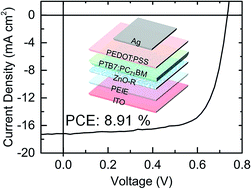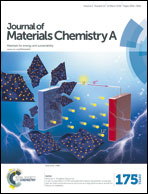Highly stable and efficient inverted organic solar cells based on low-temperature solution-processed PEIE and ZnO bilayers†
Abstract
Highly efficient and air-stable inverted organic solar cells (IOSCs) were fabricated from solution-processed non-conjugated polyethylenimine ethoxylated (PEIE) as the polyelectrolyte, a zinc oxide (ZnO) bilayer as the electron transport layer, and an active layer of thieno[3,4-b]thiophene/benzodithiophene (PTB7) and [6,6]-phenyl-C71-butyric acid methyl ester (PC71BM). When compared to conventional ZnO thin film devices, the incorporation of ZnO with nano-ridge structures (ZnO-R) and large interfacial areas, in addition to low leakage currents, led to an enhancement in power conversion efficiency from 7.41% to 8.38%. Furthermore, the presence of a thin PEIE layer between ITO and ZnO-R not only suppressed the formation of an oxygen deficient state at the ZnO-R surface, but also improved charge carrier mobilities and prevented leakage currents. Consequently, a maximum (average) efficiency of 8.91% (8.86%) and superior air stability with approximately 65% of the initial efficiency being retained after 326 days of storage under ambient atmosphere were achieved.



 Please wait while we load your content...
Please wait while we load your content...